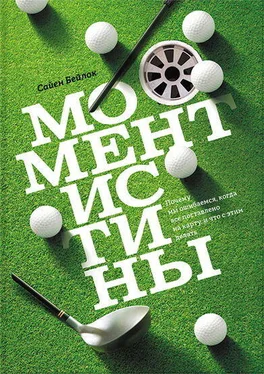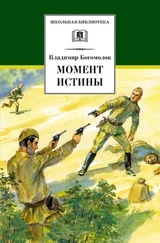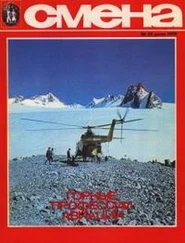11.Milton J., Solodkin A., Hlustik P., Small S. L. The mind of expert motor performance is cool and focused // Neuroimage, 2007. Vol. 35. Pp. 804–813.
Глава 2
12.Более подробно о МРТ и функциональной МРТ см.: Huettel S. A., Song A. W., McCarthy G. Functional Magnetic Resonance Imaging. Sunderland, MA: Sinauer Associates, 2004; Gazzaniga M. S., Ivry R. B., Mangun G. R. Cognitive Neuroscience: The Biology of the Mind. New York: Norton, 2002.
13.Saturday Matters with Sue Lawley, BBC Television, October 1980 // Masters R., Maxwell J. The theory of reinvestment // International Review of Sport and Exercise Psychology, 2009. Vol. 1. Pp. 160–183.
14.McCabe D. P., Castel A. D. Seeing is believing: The effect of brain images on judgments of scientific reasoning // Cognition, 2008. Vol. 107. Pp. 343–352.
15.Helsen W. F., Starkes J. L. A multidimensional approach to skilled perception and performance in sport // Applied Cognitive Psychology, 1999. Vol. 13. Pp. 1–27.
16.Helsen W. F., Van Winckel J., Williams A. M. The relative age effect in youth soccer across Europe // Journal of Sports Sciences, 2005. Vol. 23. Pp. 629–636.
17.Bisanz J., Morrison F., Dunn M. Effects of age and schooling on the acquisition of elementary quantitative skills // Developmental Psychology, 1995. Vol. 31. Pp. 221–236.
18.Cote J., MacDonald D. J., Baker J., Abernethy B. When ‘where’ is more important than ‘when’: Birthplace and birthdate effects on the achievement of sporting expertise // Journal of Sport Sciences, 2006. Vol. 24. Pp. 1065–1073. В Канаде населенные пункты с населением менее 1000 человек были исключены из исследования.
19.De Groot A. D. Thought and Choice in Chess. The Hague: Mouton, 1965.
20.Chase W. G., Simon H. A. Perception in chess // Cognitive Psychology, 1973. Vol. 4. Pp. 55–81.
21.Ericsson K. A., Polson P. G. An experimental analysis of the mechanisms of a memory skill // Journal of Experimental Psychology: Learning, Memory, & Cognition, 1988. Vol. 14. Pp. 305–316.
22.Maguire E. A. Navigation-related structural change in the hippocampi of taxi drivers // Proceedings of the National Academy of Sciences, 2000. Vol. 97. Pp. 4398–4403.
23.Draganski B. Changes in grey matter induced by training: Newly honed juggling skills show up as a transient feature on a brain-imaging scan // Nature, 2004. Vol. 427. Pp. 311–312.
24.Дополнительно см.: Münte T. F., Altenmüller E., Jäncke L. The musician’s brain as a model of neuroplasticity // Nature Reviews Neuroscience, 2002. Vol. 3. Pp. 473–478.
25.Дополнительно см.: Hernandez A. E., Li P. Age of acquisition: Its neural and computational mechanisms // Psychological Bulletin, 2007. Vol. 133. Pp. 638–650.
26.Это шкала Reinvestment Scale для спортсменов. Воспроизведено с разрешения. См.: Masters R. S. W., Eves F. F., Maxwell J. Development of a movement specific reinvestment scale // T. Morris et al., eds. Proceedings of the ISSP 11th World Congress of Sport Psychology, Sydney, Australia, 2005. Оригинальную шкалу, использованную для исследования спортсменов в сквоше и теннисе, см. в главе 7 и работе: Masters R. S. W., Polman R. C. J., Hammond N. V. ‘Reinvestment’: A dimension of personality implicated in skill breakdown under pressure // Journal of Personality and Individual Differences, 1993. Vol. 14. No. 5. Pp. 655–666.
27.Дополнительно см.: Masters R., Maxwell J. The theory of reinvestment // International Review of Sport and Exercise Psychology, 2008. Vol. 1. Pp. 160–183.
28.См.: Yarrow K., Brown P., Krakauer J. W. Inside the brain of an elite athlete: The neural processes that support high achievement in sports // Nature Reviews Neuroscience, 2009. Vol. 10. Pp. 585–596.
Глава 3
29.© American Psychological Association, 2009. Использовано с разрешения с сокращениями: Maddux W. W., Galinsky A. D. Cultural borders and mental barriers: The relationship between living abroad and creativity // Journal of Personality and Social Psychology, 2009. Vol. 96. Pp. 1047–1061. Использование информации Американской ассоциации психологов не подразумевает поддержку данной работы Ассоциацией.
30.Дополнительно см. Thompson-Schill S. L., Ramscar M., Chrysikou E. G. Cognition without control: When a little frontal lobe goes a long way // Current Directions in Psychological Science, 2009. Vol. 18. Pp. 259–263. См. также: German T. P., Defeyter M. A. Immunity to functional fixedness in young children // Psychonomic Bulletin & Review, 2000. Vol. 7. Pp. 707–712.
31.Beilock S. L., DeCaro M. S. From poor performance to success under stress: Working memory, strategy selection, and mathematical problem solving under pressure // Journal of Experimental Psychology: Learning, Memory, & Cognition, 2007. Vol. 33. Pp. 983–998.
32.Conway A. R. A., Cowan N., Bunting M. F. The cocktail party phenomenon revisited: The importance of working memory capacity // Psychonomic Bulletin and Review, 2001. Vol. 8. Pp. 331–335.
33.Kersten A. W., Earles J. L. Less really is more for adults learning a miniature artificial language // Journal of Memory and Language, 2001. Vol. 44. Pp. 250–273. Дополнительно см.: Newport E. L. Maturational constraints on language learning // Cognitive Science, 1990. Vol. 14. Pp. 11–28.
34.Reverberi C., Toraldo A., D’Agostini S., Skrap M. Better without (lateral) frontal cortex? Insight problems solved by frontal patients // Brain, 2005. Vol. 128. Pp. 2882–2890.
35.Cochran B. P., McDonald J. L., Parault S. J. Too smart for their own good: The disadvantage of a superior processing capacity for adult language learners // Journal of Memory and Language, 1999. Vol. 41. Pp. 30–58.
36.Beilock S. L., Carr T. H., MacMahon C., Starkes J. L. When paying attention becomes counterproductive: Impact of divided versus skill-focused attention on novice and experienced performance of sensorimotor skills // Journal of Experimental Psychology: Applied, 2002. Vol. 8. Pp. 6–16.
37.Ellenbogen J. M., Hu P. T., Payne J. D. et al. Human relational memory requires time and sleep // Proceedings of the National Academy of Sciences, USA, 2007. Vol. 104. Pp. 7723–7728.
38.Friedman N. P. et al. Individual differences in executive functions are almost entirely genetic in origin // Journal of Experimental Psychology: General, 2008. Vol. 137. Pp. 201–225.
39.Ward J. The Student’s Guide to Cognitive Neuroscience, 2nd ed. London: Psychology Press, 2010.
40.Klingberg T., Forssberg H., Westerberg H. Training of working memory in children with ADHD // Journal of Clinical and Experimental Neuropsychology, 2002. Vol. 24. Pp. 781–791. См. также: Klingberg T. et al. Computerized training of working memory in children with ADHD — a randomized, controlled trial // Journal of the American Academy of Child Adolescent Psychiatry, 2005. Vol. 44. Pp. 177–186. Общий обзор см.: Клинберг Т. Перегруженный мозг. Информационный поток и пределы рабочей памяти. М. : Ломоносовъ, 2010.
Читать дальше
Конец ознакомительного отрывка
Купить книгу











